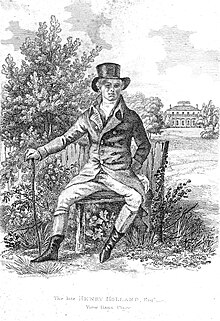|
Sloane Place Sloane Place, later The Pavilion, was a large house built by the architect Henry Holland in Knightsbridge, London, and located immediately to the south of Hans Place.[1] In 1774, Holland leased 100 acres of what had been nursery gardens from Lord Cadogan, to redevelop as housing, including Hans Place, keeping 21 acres to build a property for himself.[1] Sloane Place was built in 1780, and Holland had moved in by 1789.[1][2] There were hothouses, a vinery, fruit trees, a Gothic ice-house on the west side of a lawn and a ruined castle/priory.[2][1] Holland died there in 1806, after which it was sold on to Peter Denys,[1][3] who renamed it The Pavilion, and died there in 1816.[4] It was later subdivided, before being demolished in 1874.[1] The site of the house is now occupied by Shafto Mews[1] and is memorialised by Pavilion Road. References
|